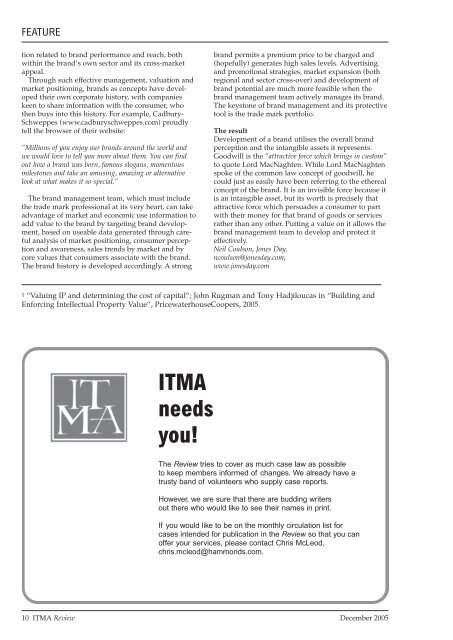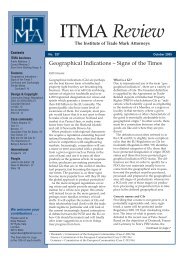ITMA 322 APRIL 2005
ITMA 322 APRIL 2005
ITMA 322 APRIL 2005
Create successful ePaper yourself
Turn your PDF publications into a flip-book with our unique Google optimized e-Paper software.
FEATURE<br />
tion related to brand performance and reach, both<br />
within the brand’s own sector and its cross-market<br />
appeal.<br />
Through such effective management, valuation and<br />
market positioning, brands as concepts have developed<br />
their own corporate history, with companies<br />
keen to share information with the consumer, who<br />
then buys into this history. For example, Cadbury-<br />
Schweppes (www.cadburyschweppes.com) proudly<br />
tell the browser of their website:<br />
“Millions of you enjoy our brands around the world and<br />
we would love to tell you more about them. You can find<br />
out how a brand was born, famous slogans, momentous<br />
milestones and take an amusing, amazing or alternative<br />
look at what makes it so special.”<br />
The brand management team, which must include<br />
the trade mark professional at its very heart, can take<br />
advantage of market and economic use information to<br />
add value to the brand by targeting brand development,<br />
based on useable data generated through careful<br />
analysis of market positioning, consumer perception<br />
and awareness, sales trends by market and by<br />
core values that consumers associate with the brand.<br />
The brand history is developed accordingly. A strong<br />
brand permits a premium price to be charged and<br />
(hopefully) generates high sales levels. Advertising<br />
and promotional strategies, market expansion (both<br />
regional and sector cross-over) and development of<br />
brand potential are much more feasible when the<br />
brand management team actively manages its brand.<br />
The keystone of brand management and its protective<br />
tool is the trade mark portfolio.<br />
The result<br />
Development of a brand utilises the overall brand<br />
perception and the intangible assets it represents.<br />
Goodwill is the “attractive force which brings in custom”<br />
to quote Lord MacNaghten. While Lord MacNaghten<br />
spoke of the common law concept of goodwill, he<br />
could just as easily have been referring to the ethereal<br />
concept of the brand. It is an invisible force because it<br />
is an intangible asset, but its worth is precisely that<br />
attractive force which persuades a consumer to part<br />
with their money for that brand of goods or services<br />
rather than any other. Putting a value on it allows the<br />
brand management team to develop and protect it<br />
effectively.<br />
Neil Coulson, Jones Day,<br />
ncoulson@jonesday.com,<br />
www.jonesday.com<br />
1 “Valuing IP and determining the cost of capital”; John Rugman and Tony Hadjiloucas in “Building and<br />
Enforcing Intellectual Property Value”, PricewaterhouseCoopers, <strong>2005</strong>.<br />
<strong>ITMA</strong><br />
needs<br />
you!<br />
The Review tries to cover as much case law as possible<br />
to keep members informed of changes. We already have a<br />
trusty band of volunteers who supply case reports.<br />
However, we are sure that there are budding writers<br />
out there who would like to see their names in print.<br />
If you would like to be on the monthly circulation list for<br />
cases intended for publication in the Review so that you can<br />
offer your services, please contact Chris McLeod,<br />
chris.mcleod@hammonds.com.<br />
10 <strong>ITMA</strong> Review December <strong>2005</strong>
















